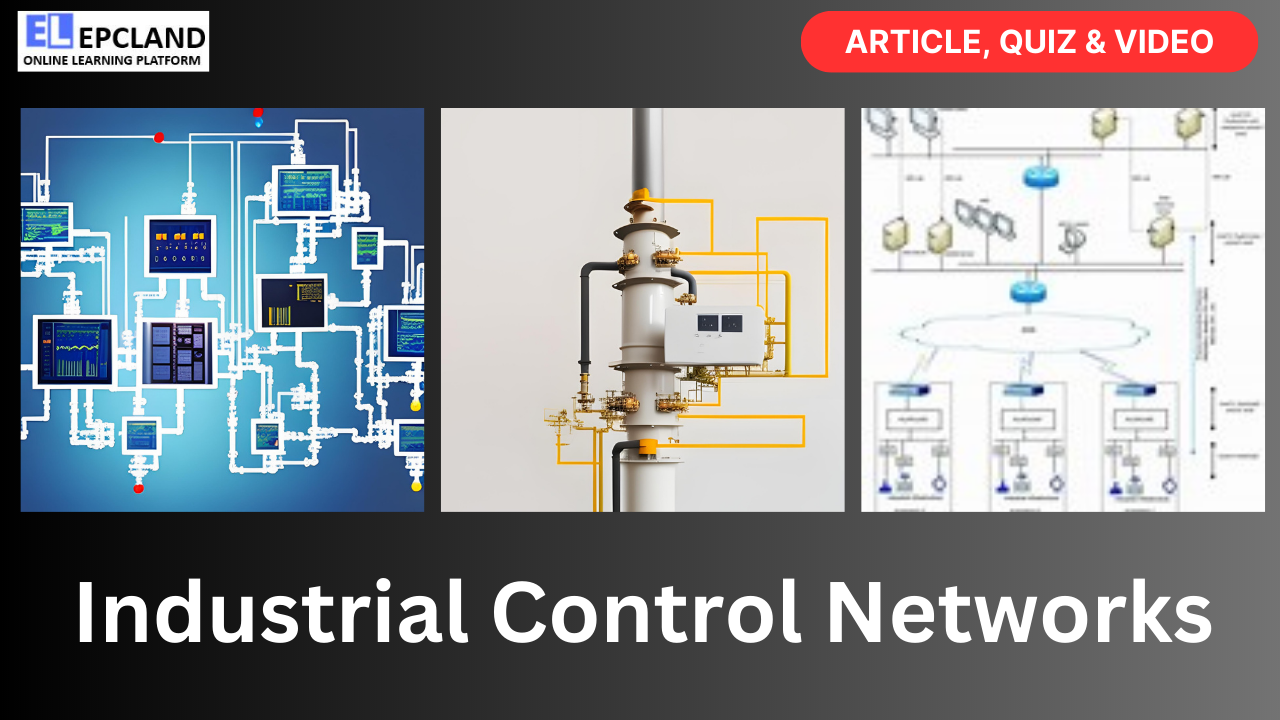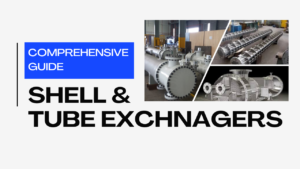The Oil & Gas Industry operates on a colossal scale, involving complex processes and vast infrastructures. To manage and optimize these operations, Industrial Control Networks play a pivotal role. In this article, we delve into the world of Industrial Control Networks, exploring their significance, working principles, challenges, and the technologies that underpin their operation within the Oil & Gas sector.
Table of Contents
Do not miss the Complete Course on Piping Engineering
By EPCLand
Introduction
The Oil & Gas Industry encompasses a range of activities, from exploration and extraction to refining and distribution. These operations are spread across remote and hazardous environments, making efficient control and monitoring systems imperative. Industrial Control Networks serve as the nervous system of this industry, enabling real-time data acquisition, process control, and safety management.
Significance of Industrial Control Networks
Real-time Monitoring
One of the primary functions of Industrial Control Networks is real-time monitoring. In the Oil & Gas Industry, continuous surveillance of variables such as pressure, temperature, flow rates, and equipment statuses is essential for safe and efficient operations. Industrial Control Networks facilitate the collection and transmission of this critical data.
Process Control
Precise control of industrial processes is paramount. Control systems in the Oil & Gas Industry use data from sensors and actuators connected through these networks to make instantaneous adjustments. For example, in a refinery, control systems regulate the flow of crude oil, adjust temperatures in distillation columns, and manage the blending of various petroleum products.
Safety Management
Safety is non-negotiable in the Oil & Gas Industry. Industrial Control Networks enable the integration of safety systems, including emergency shutdowns and alarms, that respond to hazardous conditions. In the event of a gas leak or equipment malfunction, these networks trigger safety protocols to prevent accidents and protect personnel and assets.
Remote Operations
Many Oil & Gas facilities are located in remote and harsh environments, such as offshore platforms and deserts. Industrial Control Networks allow for remote monitoring and control, reducing the need for personnel to be physically present in these challenging locations. This not only enhances safety but also reduces operational costs.
Working Principles of Industrial Control Networks
Industrial Control Networks operate based on several key principles:
Data Acquisition
The process begins with sensors and actuators distributed throughout the industrial environment. Sensors capture data from physical parameters, while actuators execute control actions. These devices continuously gather data and send it to controllers.
Control and Decision-Making
Controllers, such as Programmable Logic Controllers (PLCs) and Distributed Control Systems (DCS), receive data from sensors. They process this data and make control decisions based on predefined algorithms and setpoints. Control signals are then sent to actuators to adjust processes accordingly.
Data Transmission
Data communication is a critical aspect of Industrial Control Networks. Communication infrastructure, including wired and wireless connections, facilitates the transmission of data between sensors, controllers, and other network components. Ethernet-based architectures are commonly used for high-speed and reliable data transfer.
Human-Machine Interface (HMI)
Operators interact with the system through Human-Machine Interface (HMI) devices, such as computer screens or control panels. HMIs provide a visual representation of industrial processes, allowing operators to monitor equipment statuses, view real-time data, and make control decisions.
Components of Industrial Control Networks
Industrial Control Networks comprise several key components that work together to facilitate data communication, control, and monitoring. These components include:
Sensors and Actuators
Sensors detect physical parameters like pressure, temperature, and flow rates, while actuators execute control actions based on data received from sensors. These devices form the foundation of data acquisition and control.
Controllers
Controllers, such as Programmable Logic Controllers (PLCs) and Distributed Control Systems (DCS), are the brains of Industrial Control Networks. They receive data from sensors, process it, and send control signals to actuators. PLCs are often used for discrete control tasks, while DCS systems manage complex processes.
Communication Infrastructure
Communication infrastructure is crucial for transmitting data between sensors, controllers, and other network components. In the Oil & Gas Industry, wired and wireless communication protocols are used to ensure reliable and secure data transfer.
Human-Machine Interface (HMI)
HMIs provide operators with a visual representation of the industrial processes. Operators can monitor equipment statuses, view real-time data, and make control decisions through these interfaces.
Network Architecture
Network architecture defines how devices are connected and communicate within the network. Industrial Control Networks often use Ethernet-based architectures for high-speed data transmission and redundancy to ensure system availability.
Do not miss the Complete Course on Piping Engineering
By EPCLand
Types of Industrial Control Networks
Several types of Industrial Control Networks are employed in the Oil & Gas Industry, each designed to meet specific requirements and constraints. Some common types include:
Supervisory Control and Data Acquisition (SCADA)
SCADA systems are widely used in the Oil & Gas Industry for remote monitoring and control. They are employed in pipeline operations, wellhead monitoring, and distribution networks. SCADA systems collect data from remote locations and send it to a central control center, where operators can make informed decisions.
Process Control Networks
Process control networks focus on managing complex industrial processes. They integrate various control systems, including PLCs and DCS, to ensure seamless operation. These networks are prevalent in refineries, chemical plants, and offshore platforms.
Safety Instrumented Systems (SIS)
Safety Instrumented Systems are dedicated to ensuring safety in critical processes. They are designed to detect and mitigate potentially hazardous situations. In the Oil & Gas Industry, SIS are used to manage emergency shutdowns and implement safety interlocks.
Distributed Control Systems (DCS)
DCS systems provide centralized control and monitoring capabilities for large-scale industrial processes. They are extensively used in Oil & Gas refineries and petrochemical plants. DCS systems allow operators to manage numerous variables and control loops efficiently.
Advantages and Disadvantages of Industrial Control Networks
Industrial Control Networks offer numerous advantages, but they also come with some disadvantages. Here’s a table summarizing the key points:
| Advantages | Disadvantages |
|---|---|
| 1. Real-time Monitoring for Efficiency | 1. Cybersecurity Vulnerabilities |
| 2. Precise Process Control | 2. Compatibility and Interoperability Issues |
| 3. Enhanced Safety Management | 3. Legacy Systems |
| 4. Remote Operations for Cost Reduction | 4. Redundancy and Reliability Challenges |
| 5. Integration of Advanced Technologies |
Challenges in Implementing Industrial Control Networks
While Industrial Control Networks offer significant advantages, their implementation in the Oil & Gas Industry comes with challenges:
Cybersecurity
As Industrial Control Networks become more interconnected and data-centric, they become vulnerable to cyberattacks. Protecting these networks from malicious actors is a top priority. Robust cybersecurity measures, including firewalls, intrusion detection systems, and regular security audits, are essential.
Compatibility and Interoperability
The Oil & Gas Industry relies on a diverse range of equipment and systems, often from different manufacturers. Ensuring the compatibility and interoperability of these systems within Industrial Control Networks can be challenging. Standardization efforts, such as the OPC Unified Architecture (OPC UA), aim to address this issue.
Legacy Systems
Many Oil & Gas facilities have legacy control systems that may not be compatible with modern Industrial Control Networks. Retrofitting these systems to work within the network infrastructure can be expensive and complex.
Redundancy and Reliability
Industrial Control Networks must be highly reliable, especially in critical applications like offshore drilling and pipeline transportation. Implementing redundancy and failover mechanisms is essential to ensure uninterrupted operations.
Technologies Underpinning Industrial Control Networks
Several cutting-edge technologies underpin the operation and evolution of Industrial Control Networks in the Oil & Gas Industry:
Internet of Things (IoT)
IoT devices, including sensors and edge computing devices, are increasingly integrated into Industrial Control Networks. These devices provide real-time data from remote locations, enhancing monitoring and decision-making capabilities.
Edge Computing
Edge computing involves processing data at or near the source, reducing latency and improving response times. In the Oil & Gas Industry, edge computing is used to analyze data from sensors in real-time, enabling faster decision-making.
Artificial Intelligence (AI) and Machine Learning
AI and machine learning algorithms analyze large volumes of data generated by Industrial Control Networks. These algorithms can predict equipment failures, optimize processes, and identify anomalies that may indicate safety hazards.
5G Connectivity
The deployment of 5G networks enhances the communication capabilities of Industrial Control Networks. It provides high-speed, low-latency connectivity, enabling real-time data transmission and remote operations in previously challenging environments.
Applications of Industrial Control Networks in Oil & Gas Projects
Industrial Control Networks find applications across various segments of the Oil & Gas Industry:
Exploration and Drilling
In the exploration and drilling phase, Industrial Control Networks monitor drilling parameters, well pressures, and geological data. This data helps operators make informed decisions about well placement and drilling techniques, reducing exploration risks.
Refining and Processing
In refineries and processing plants, Industrial Control Networks manage complex processes involving chemical reactions and separation. They optimize temperature control, flow rates, and the blending of different petroleum products, ensuring efficient production.
Pipeline Transportation
Pipelines are the lifelines of the Oil & Gas Industry, and their safe and efficient operation relies on Industrial Control Networks. These networks monitor pressure, flow rates, and detect leaks in real-time, allowing operators to respond swiftly to incidents.
Offshore Operations
Offshore platforms operate in challenging environments, making remote monitoring and control essential. Industrial Control Networks enable operators to oversee equipment health, manage production rates, and respond to changing conditions without the need for on-site personnel.
Do not miss the Complete Course on Piping Engineering
By EPCLand
Future Trends in Industrial Control Networks
The future of Industrial Control Networks in the Oil & Gas Industry holds several exciting possibilities:
Edge AI
Combining edge computing with AI will allow Industrial Control Networks to make autonomous decisions in real-time, reducing the need for human intervention and further enhancing safety and efficiency.
Blockchain for Supply Chain Management
Blockchain technology is being explored to improve supply chain transparency in the Oil & Gas Industry. It can track the movement of oil and gas from extraction to distribution, enhancing traceability and reducing fraud.
Quantum Computing
Quantum computing has the potential to revolutionize data analysis and optimization within Industrial Control Networks. Its immense computational power can solve complex problems faster than classical computers.
6G Connectivity
The deployment of 6G networks, expected in the coming years, will further enhance Industrial Control Networks’ capabilities, enabling unprecedented data speeds and connectivity.
Conclusion
Industrial Control Networks are the backbone of the Oil & Gas Industry, enabling efficient operations, real-time monitoring, and safety management. These networks bring together a range of technologies, from sensors and controllers to advanced AI and connectivity solutions. As the industry continues to evolve, Industrial Control Networks will play an increasingly crucial role in ensuring its success, sustainability, and safety.
In this article, we’ve explored the significance of Industrial Control Networks, their working principles, components, types, challenges, and the technologies that underpin their operation. We’ve also discussed their applications in different Oil & Gas segments and examined future trends that promise to shape the landscape of these networks.
As the Oil & Gas Industry embraces innovation and adapts to changing demands, Industrial Control Networks will remain at the forefront, driving efficiency, safety, and the responsible management of valuable resources.
FAQs
1. What is the primary role of Industrial Control Networks in the Oil & Gas Industry?
Industrial Control Networks in the Oil & Gas Industry primarily serve to enable real-time monitoring, precise control of processes, safety management, and remote operations. They ensure efficient and safe operation of complex oil and gas projects.
2. How do Industrial Control Networks enhance safety in the Oil & Gas Industry?
Industrial Control Networks integrate safety systems, including emergency shutdowns and alarms, that respond to hazardous conditions. They detect safety hazards, trigger safety protocols, and prevent accidents, protecting personnel and assets.
3. What are some of the key challenges in implementing Industrial Control Networks in the Oil & Gas sector?
Challenges include cybersecurity vulnerabilities, compatibility and interoperability issues with diverse equipment, dealing with legacy control systems, and ensuring redundancy and reliability in critical applications.
4. What are the emerging technologies that are shaping the future of Industrial Control Networks in the Oil & Gas Industry?
Emerging technologies include the Internet of Things (IoT) for real-time data collection, edge computing for faster decision-making, artificial intelligence (AI) for predictive analytics, and 5G connectivity for improved communication.
5. How can Industrial Control Networks be adapted to the remote and harsh environments often found in the Oil & Gas Industry, such as offshore platforms and deserts?
Industrial Control Networks enable remote monitoring and control, reducing the need for personnel to be physically present in challenging locations. They use ruggedized equipment, redundant communication paths, and advanced sensors to operate in such environments while ensuring safety and efficiency.
Do not miss the Complete Course on Piping Engineering
By EPCLand
Recommended courses (Published on EPCLand)
- Basics of Piping Engineering
- Piping Layout Engineering
- Piping Material Engineering
- Piping Stress Analysis
- Complete Course on Piping Engineering
- Material Requisitions
- Piping Material Specifications
- Valve Material Specifications
Don’t miss the published articles on following:
| Industrial Applications with Link | Industrial Applications with Link |
| Corrosion Monitoring Instruments | Safety Instrumented Systems |
| Instrumentation in Renewable Energy | Safety Relief Valves |
| Orifice Plate in the Oil & Gas Industry | Well Test Instruments |
| Wellhead Pressure and Temperature Gauges | Wireless Instrumentation in Oil & Gas Projects |
Related Video
Attempt Quiz
Question 1:
What is the primary purpose of Industrial Control Networks in oil & gas projects?
Explanation: The primary purpose of Industrial Control Networks in oil & gas projects is to monitor and control industrial processes and equipment, ensuring efficient operations.
Question 2:
Which communication protocol is commonly used in Industrial Control Networks for oil & gas applications?
Explanation: The Modbus communication protocol is commonly used in Industrial Control Networks for oil & gas applications to facilitate data exchange between devices.
Question 3:
Why is cybersecurity important in Industrial Control Networks for oil & gas projects?
Explanation: Cybersecurity is important in Industrial Control Networks for oil & gas projects to prevent unauthorized access and protect against cyber threats that could disrupt operations.
Question 4:
What is SCADA (Supervisory Control and Data Acquisition) used for in the oil & gas industry?
Explanation: SCADA (Supervisory Control and Data Acquisition) is used in the oil & gas industry to monitor and control industrial processes in real-time, ensuring efficient operations.
Question 5:
What is the main benefit of using Industrial Control Networks in oil & gas projects?
Explanation: The main benefit of using Industrial Control Networks in oil & gas projects is to improve operational efficiency and safety, leading to more reliable and profitable operations.



